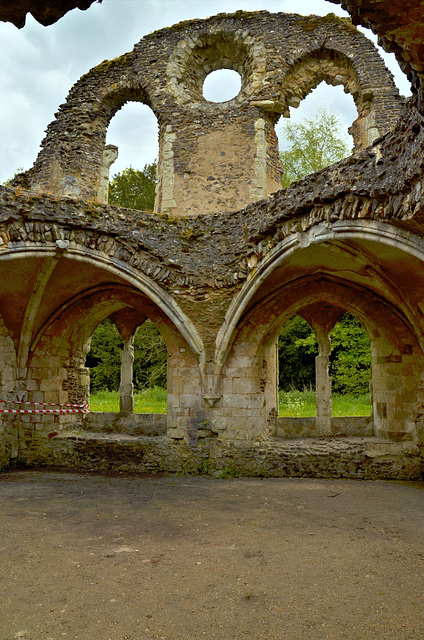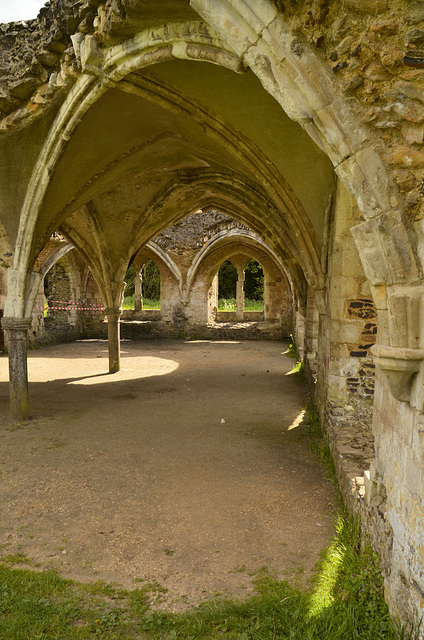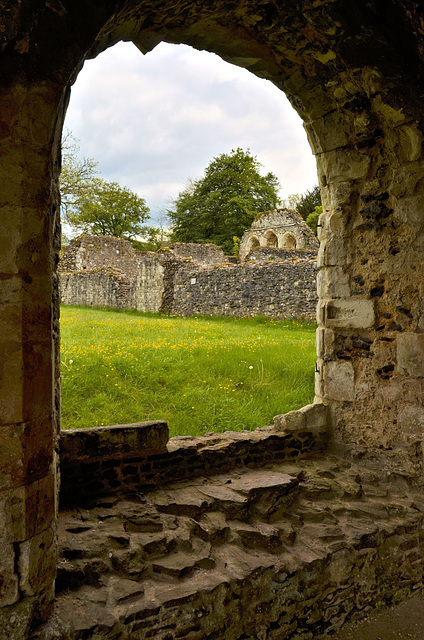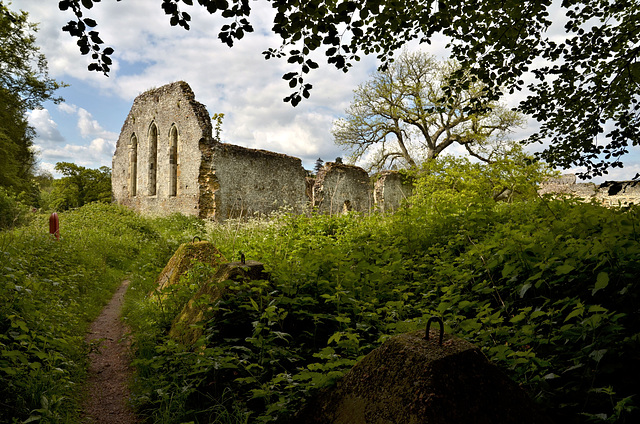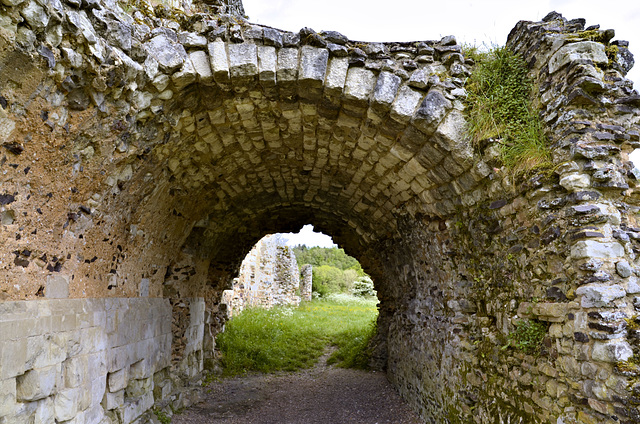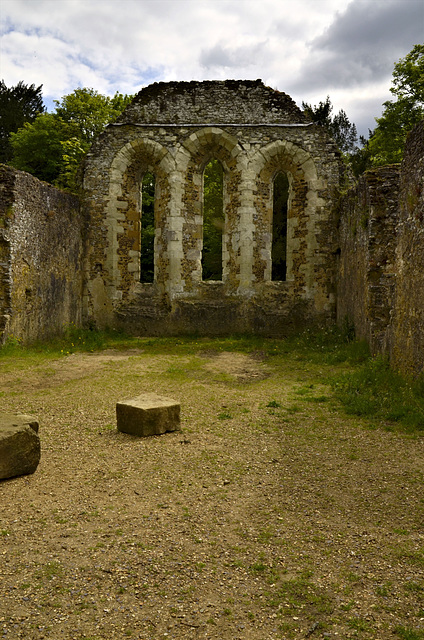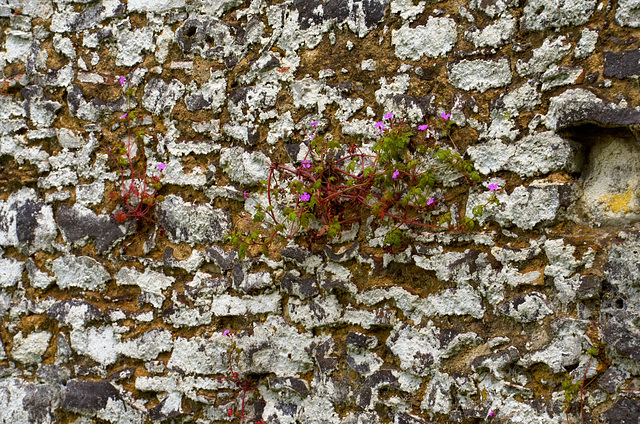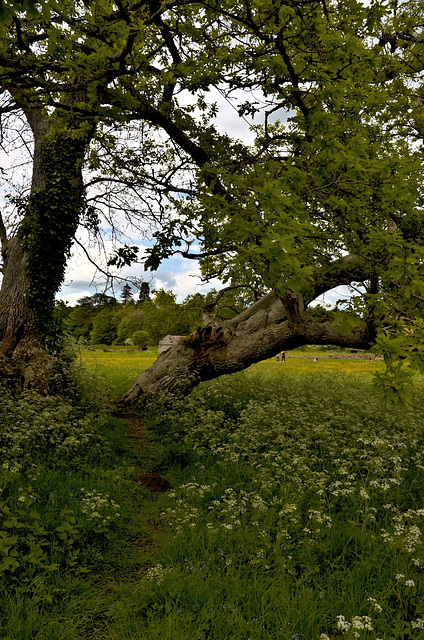
Waverley Abbey
Waverley Abbey was the first Cistercian abbey in England.
It was founded in 1128 by William Giffard, Bishop of Winchester.
The abbey was closed in 1536 as part of King Henry VIII's
Dissolution of the Monasteries. Subsequently largely demolished,
its stone was reused in local buildings,
including "Waverley Abbey House", which was built in 1723.
Only part of the abbey remains standing, with the…
(read more)
15 May 2014
Waverley Abbey ruins - Lay Brothers Refectory 2014
Waverley Abbey was the first Cistercian abbey in England.
It was founded in 1128 by William Giffard, Bishop of Winchester.
The abbey was closed in 1536 as part of King Henry VIII's
Dissolution of the Monasteries. Subsequently largely demolished,
its stone was reused in local buildings,
including "Waverley Abbey House", which was built in 1723.
Only part of the abbey remains standing, with the ruins dating
from the abbey's 13th-century reconstruction.
The most substantial remains are that of the vaulted undercroft,
or cellar, of the lay brother's refectory, and the walls of the monk's
dormitory, which largely survive to roof height.
The ruins of the abbey are a Scheduled Ancient Monument
currently managed by English Heritage.
(Extracted from Wikipedia)
15 May 2014
3 favorites
3 comments
Waverley Abbey ruins - Lay Brothers Refectory Undercroft
Waverley Abbey was the first Cistercian abbey in England.
It was founded in 1128 by William Giffard, Bishop of Winchester.
The abbey was closed in 1536 as part of King Henry VIII's
Dissolution of the Monasteries. Subsequently largely demolished,
its stone was reused in local buildings,
including "Waverley Abbey House", which was built in 1723.
Only part of the abbey remains standing, with the ruins dating
from the abbey's 13th-century reconstruction.
The most substantial remains are that of the vaulted undercroft,
or cellar, of the lay brother's refectory, and the walls of the monk's
dormitory, which largely survive to roof height.
The ruins of the abbey are a Scheduled Ancient Monument
currently managed by English Heritage.
(Extracted from Wikipedia)
15 May 2014
Waverley Abbey ruins - Lay Brothers Refectory
Waverley Abbey was the first Cistercian abbey in England.
It was founded in 1128 by William Giffard, Bishop of Winchester.
The abbey was closed in 1536 as part of King Henry VIII's
Dissolution of the Monasteries. Subsequently largely demolished,
its stone was reused in local buildings,
including "Waverley Abbey House", which was built in 1723.
Only part of the abbey remains standing, with the ruins dating
from the abbey's 13th-century reconstruction.
The most substantial remains are that of the vaulted undercroft,
or cellar, of the lay brother's refectory, and the walls of the monk's
dormitory, which largely survive to roof height.
The ruins of the abbey are a Scheduled Ancient Monument
currently managed by English Heritage.
(Extracted from Wikipedia)
15 May 2014
2 comments
Waverley Abbey ruins - window opening 2014
Waverley Abbey was the first Cistercian abbey in England.
It was founded in 1128 by William Giffard, Bishop of Winchester.
The abbey was closed in 1536 as part of King Henry VIII's
Dissolution of the Monasteries. Subsequently largely demolished,
its stone was reused in local buildings,
including "Waverley Abbey House", which was built in 1723.
Only part of the abbey remains standing, with the ruins dating
from the abbey's 13th-century reconstruction.
The most substantial remains are that of the vaulted undercroft,
or cellar, of the lay brother's refectory, and the walls of the monk's
dormitory, which largely survive to roof height.
The ruins of the abbey are a Scheduled Ancient Monument
currently managed by English Heritage.
(Extracted from Wikipedia)
15 May 2014
8 favorites
Waverley Abbey ruins and WW2 tank traps
Waverley Abbey was the first Cistercian abbey in England.
It was founded in 1128 by William Giffard, Bishop of Winchester.
The abbey was closed in 1536 as part of King Henry VIII's
Dissolution of the Monasteries. Subsequently largely demolished,
its stone was reused in local buildings,
including "Waverley Abbey House", which was built in 1723.
Only part of the abbey remains standing, with the ruins dating
from the abbey's 13th-century reconstruction.
The most substantial remains are that of the vaulted undercroft,
or cellar, of the lay brother's refectory, and the walls of the monk's
dormitory, which largely survive to roof height.
The ruins of the abbey are a Scheduled Ancient Monument
currently managed by English Heritage.
(Extracted from Wikipedia)
15 May 2014
1 favorite
Waverley Abbey ruins - vaulting structure detail
Waverley Abbey was the first Cistercian abbey in England.
It was founded in 1128 by William Giffard, Bishop of Winchester.
The abbey was closed in 1536 as part of King Henry VIII's
Dissolution of the Monasteries. Subsequently largely demolished,
its stone was reused in local buildings,
including "Waverley Abbey House", which was built in 1723.
Only part of the abbey remains standing, with the ruins dating
from the abbey's 13th-century reconstruction.
The most substantial remains are that of the vaulted undercroft,
or cellar, of the lay brother's refectory, and the walls of the monk's
dormitory, which largely survive to roof height.
The ruins of the abbey are a Scheduled Ancient Monument
currently managed by English Heritage.
(Extracted from Wikipedia)
15 May 2014
Waverley Abbey ruins
Waverley Abbey was the first Cistercian abbey in England.
It was founded in 1128 by William Giffard, Bishop of Winchester.
The abbey was closed in 1536 as part of King Henry VIII's
Dissolution of the Monasteries. Subsequently largely demolished,
its stone was reused in local buildings,
including "Waverley Abbey House", which was built in 1723.
Only part of the abbey remains standing, with the ruins dating
from the abbey's 13th-century reconstruction.
The most substantial remains are that of the vaulted undercroft,
or cellar, of the lay brother's refectory, and the walls of the monk's
dormitory, which largely survive to roof height.
The ruins of the abbey are a Scheduled Ancient Monument
currently managed by English Heritage.
(Extracted from Wikipedia)
15 May 2014
1 comment
Waverley Abbey ruins - stone wall detail with plant growth
Waverley Abbey was the first Cistercian abbey in England.
It was founded in 1128 by William Giffard, Bishop of Winchester.
The abbey was closed in 1536 as part of King Henry VIII's
Dissolution of the Monasteries. Subsequently largely demolished,
its stone was reused in local buildings,
including "Waverley Abbey House", which was built in 1723.
Only part of the abbey remains standing, with the ruins dating
from the abbey's 13th-century reconstruction.
The most substantial remains are that of the vaulted undercroft,
or cellar, of the lay brother's refectory, and the walls of the monk's
dormitory, which largely survive to roof height.
The ruins of the abbey are a Scheduled Ancient Monument
currently managed by English Heritage.
(Extracted from Wikipedia)
15 May 2014
Waverley Abbey ruins - tree
Waverley Abbey was the first Cistercian abbey in England.
It was founded in 1128 by William Giffard, Bishop of Winchester.
The abbey was closed in 1536 as part of King Henry VIII's
Dissolution of the Monasteries. Subsequently largely demolished,
its stone was reused in local buildings,
including "Waverley Abbey House", which was built in 1723.
Only part of the abbey remains standing, with the ruins dating
from the abbey's 13th-century reconstruction.
The most substantial remains are that of the vaulted undercroft,
or cellar, of the lay brother's refectory, and the walls of the monk's
dormitory, which largely survive to roof height.
The ruins of the abbey are a Scheduled Ancient Monument
currently managed by English Heritage.
(Extracted from Wikipedia)
Jump to top
RSS feed- Latest items - Subscribe to the latest items added to this album
- ipernity © 2007-2024
- Help & Contact
|
Club news
|
About ipernity
|
History |
ipernity Club & Prices |
Guide of good conduct
Donate | Group guidelines | Privacy policy | Terms of use | Statutes | In memoria -
Facebook
Twitter

